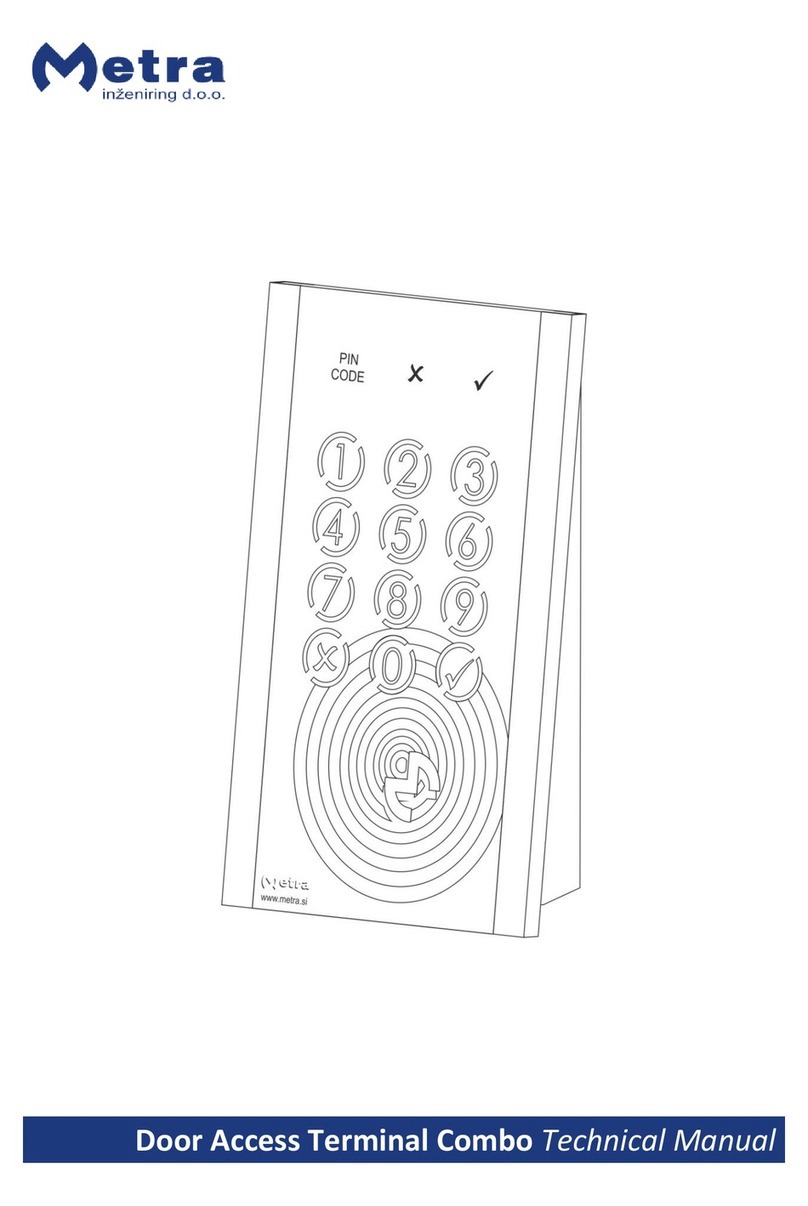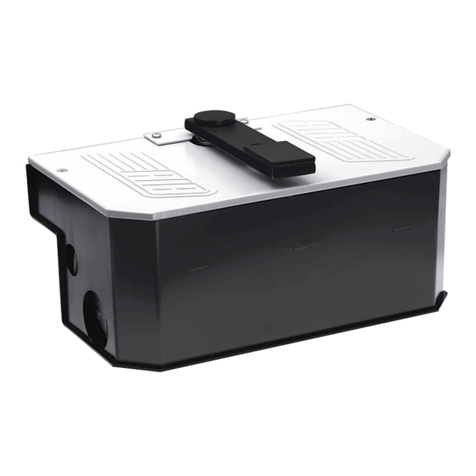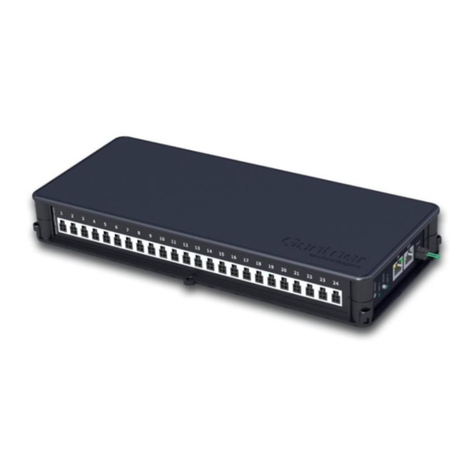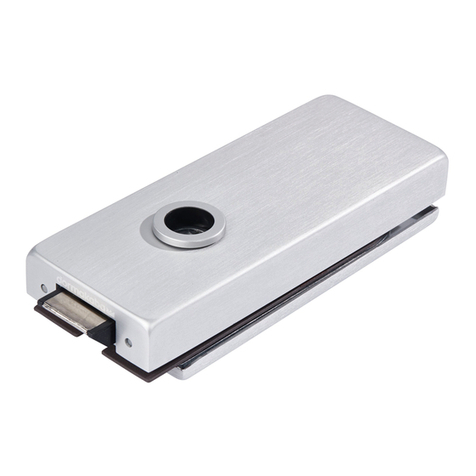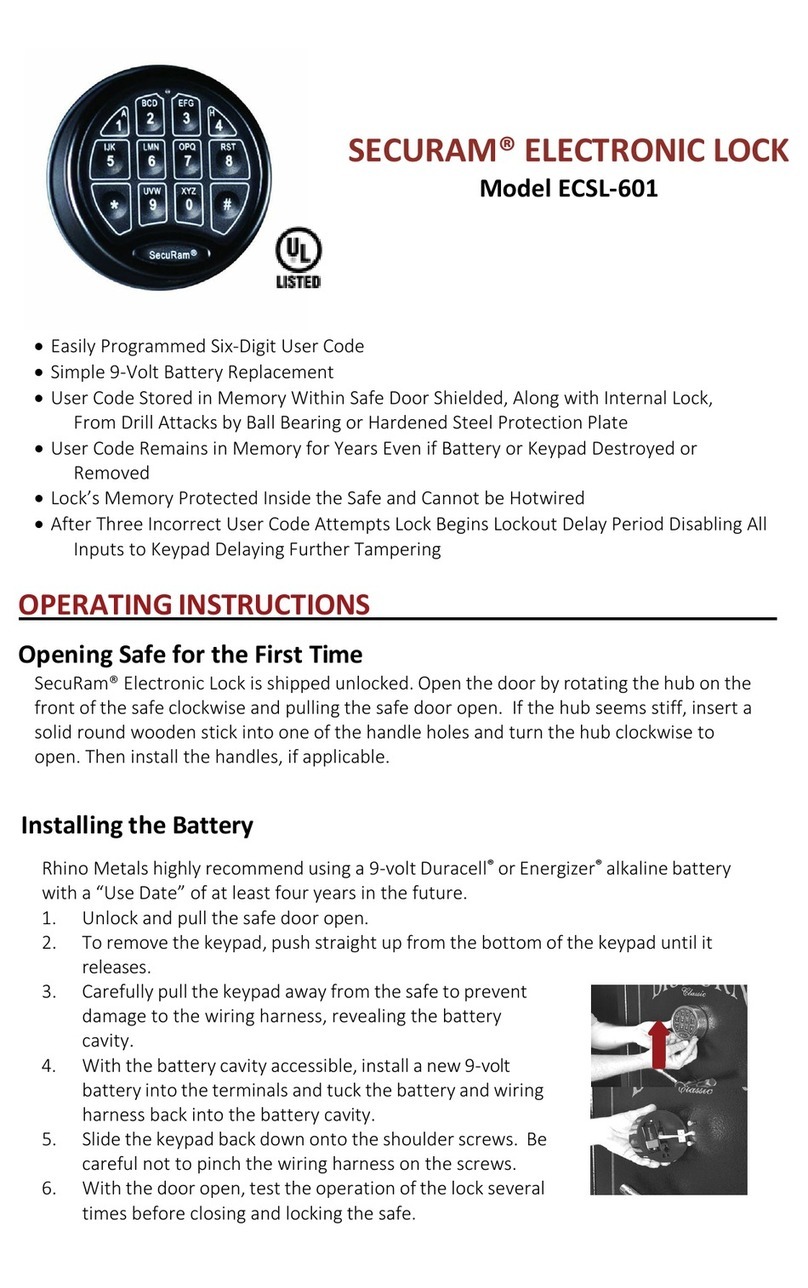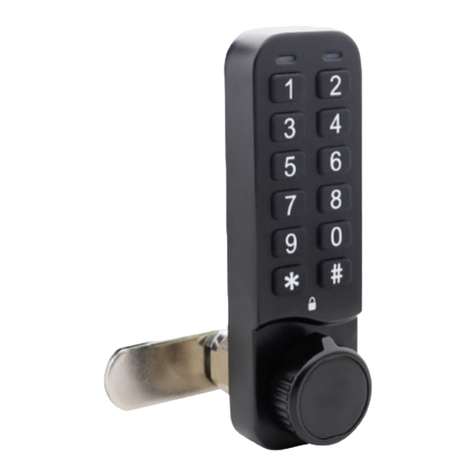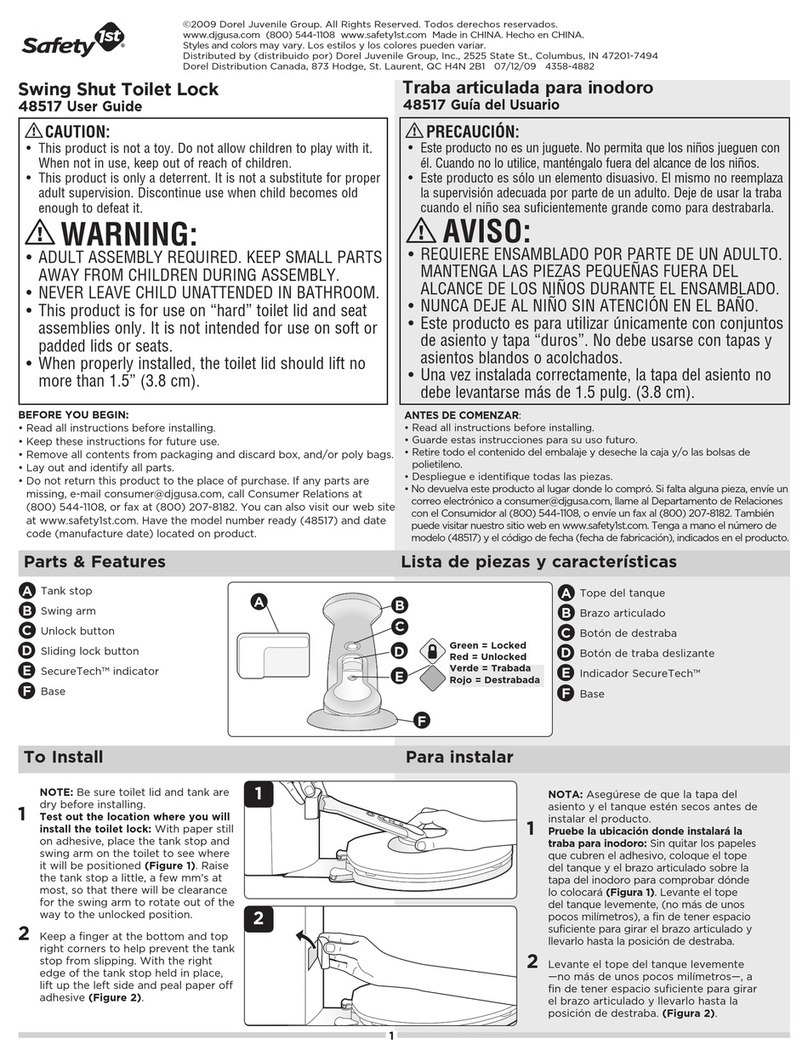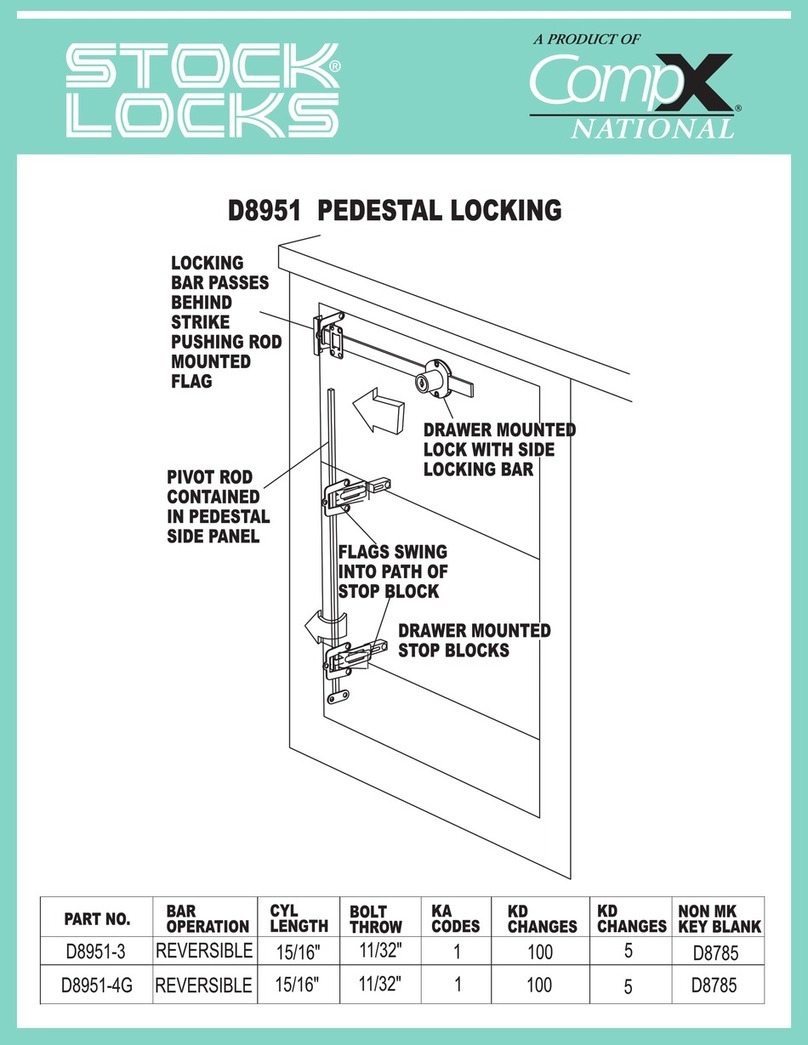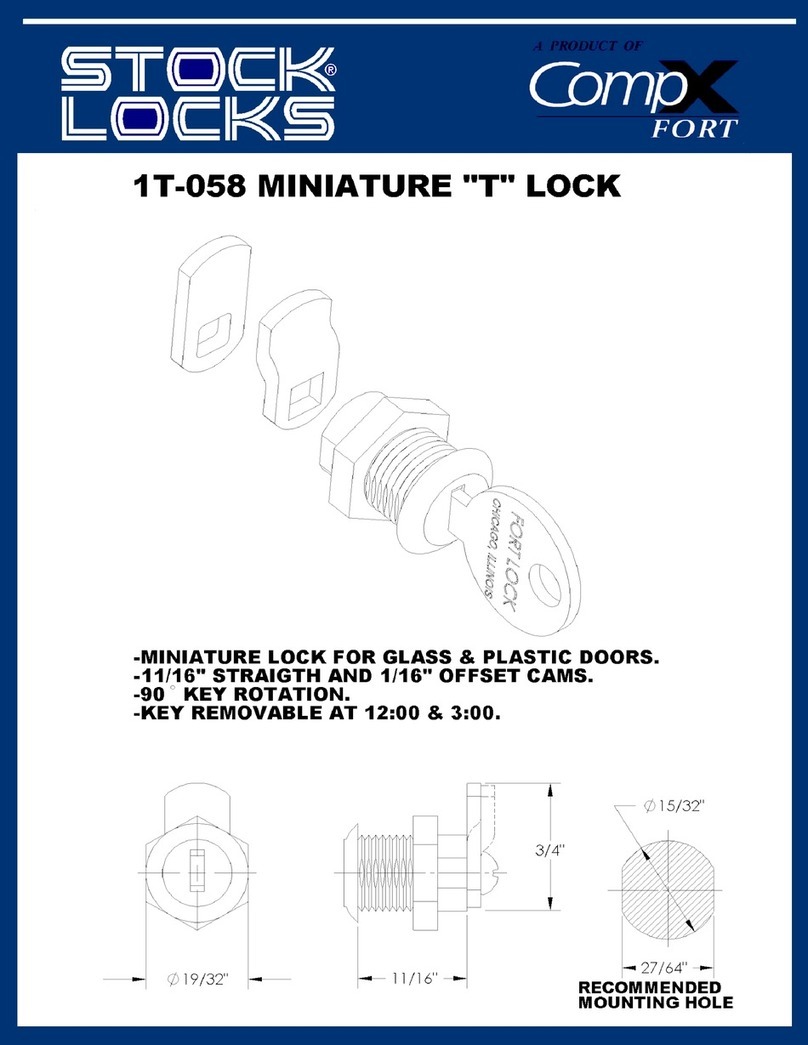
ISTRUZIONI DI MONTAGGIO MANIGLIE SU ROSETTE
ASSEMBLY INSTRUCTIONS FOR HANDLE ON ROSES
Pos.5
Inserire il ferro quadro (1) nella serratura mantenendo
la scanalatura verso il basso (Fig.01), rispettare
la sporgenza che deve essere uguale su entrambi i
lati della porta (Fig.02) e mantenere il ferro quadro
(1) perpendicolare al piano della porta (Fig.03). Su
entrambi i lati della porta segnare i fori delle viti
utilizzando la dima in dotazione. Applicare la dima
inserendola sul ferro quadro (1) tramite l’apposito foro
quadro, ed allinearla verticalmente alla porta, la dima
è predisposta per la segnatura dei fori vite per rosette
e bocchette Patent con interasse 70mm / 90mm,
per il foro clindro Yale posizionare la sottobocchetta
sul cilindro per la segnatura dei fori, eseguire la
preforatura usando una punta da D.2mm ad una
profondità di circa 2mm.
Su entrambi i lati della porta applicare le sottorosette
(2B) sul ferro quadro e fissare con le viti (A)
rispettando la posizione della tacca inferiore (Fig.08),
Applicare le rosette (3) sulle sottorosette rispettando
la posizione della tacca inferiore (Fig.08). Applicare
le rondelle in nylon (R) sul colletto delle maniglie. Sul
lato destro della porta applicare la maniglia destra (5)
sul ferro quadro mantenendo la stessa sporgenza del
ferro quadro su entrami i lati, avvitare a fondo la vite
grano (7) utilizzando la chiave (8). Sul lato sinistro
ripetere l’operazione applicando la maniglia sinistra
(6) sul ferro quadro, mantenere entrambe le maniglie
bene in appoggio sulle rosette e fissare avvitando a
fondo la vite grano.
Sul lato destro della porta posizionare la
sottobocchetta (9) mantenendo la tacca inferiore
verso il basso (Fig.08) , e allinearla all’asse della porta
(Fig.06) facendo attenzione alla centratura tra foro
chiave bocchetta e foro chiave serratura. Fissare la
sottobocchetta con le viti (A), applicare la bocchetta
(10) rispettando la posizione della tacca inferiore
(Fig.08). Ripetere le operazioni per fissare l’altra
bocchetta sul lato sinistro della porta.
Pos.5
Place the square spindle (1) through the lock with the
greve facing down (Fig.01), paying attention to keep
the same projection of the square spindle on both
sides of the door (Fig.02) and keeping it perpendicular
to the door leaf (Fig.03). Mark the screw holes on
both sides of the door by using the provided template.
Apply the template sliding it on the square spindle (1)
in correspondence of the relevant spindle hole and
aligning it vertically to the door. The template is pre-
disposed for marking the screw holes for roses and
keyhole escutcheons for the centers of 70mm/90mm,
for the euro cylinder hole, place the inner nylon base
for the escutcheons on the cylinder for the marking of
the screw holes. Perform a pre-drilling of the screw
holes using a D.2mm tip for a depth of approx. 2mm.
On both sides of the door fix the spring inner roses
(2B) by using the provided screws (A) keeping the
notch facing down (Fig.08). Apply the rose covers
(3) on the spring inner roses keeping the notch facing
down (Fig.08). Place the nylon washers (R) on the
collar of the levers. Slide both levers (right hand 5 •
left hand 6) on the square spindle - keeping the same
projection of the square spindle on both sides. Fix the
levers by keeping them firmly against the roses while
tightening the grub-screws (7) with the allen key (8).
On the right side of the door place the inner nylon
base for the escutcheon (9) keeping the notch facing
down (Fig.08), align il to the door axis (Fig. 06) paying
attention to the centering of the key hole between the
inner nylon base and the key hole lock.
Fix the keyhole/euro cylinder profile nylon inner
base (9) by using the provided screws (A). Apply the
keyhole/euro cylinder profile escutcheon cover (10)
keeping the notch facing down (Fig.08). Repeat the
operation on the left side of the door. When using euro
cylinder profile escutcheons (for the square version),
remove the central oval section from the nylon inner
rose base (Fig.07).
Pos.6
Inserire il ferro quadro (1) nella serratura mantenendo
la scanalatura verso il basso (Fig.01), rispettare la
sporgenza che deve essere uguale su entrambi i lati
della porta (Fig.02) e mantenere il ferro quadro (1)
perpendicolare al piano dellla porta (Fig.03) Nel caso
di porte senza preforatura dei fori vite tiranti utilizzare
la dima in dotazione.
Su entrambi i lati applicare la dima inserendola sul ferro
quadro (1) tramite l’apposito foro quadro, allinearla
verticalmente alla porta e segnare i fori con interasse
38mm , la dima è predisposta per la segnatura dei fori
vite per rosette e bocchetta Patent con interasse da
70mm 190mm, per il foro cilindro Yale posizionare
la sottobocchetta sul cilindro per la segnatura dei
fori, su entrambi i lati eseguire la foratura con una
punta da 7mm fino al vano della serratura, applicare
le sottorosette (2B) sul ferro quadro mantenendo la
tacca inferiore verso il basso (Fig.08), fissarle con le
viti tiranti (A) e le controviti (B). Applicare le rosette (3)
sulle sottorosette rispettando la posizione della tacca
inferiore (Fig.08).
Applicare le rondelle in nylon (R) sul colletto delle
maniglie. Sul lato destro della porta applicare la
maniglia destra (5) sul ferro quadro mantenendo la
stessa sporgenza del ferro quadro su entrambi i lati ,
avvitare a fondo la vite grano (7) utilizzando la chiave
(8).
Sul lato sinistro ripetere l’operazione applicando la
maniglia sinistra (6) sul ferro quadro, mantenere
entrambe le maniglie bene in appoggio sulle rosette e
fissare avvitando a fondo la vite grano.
Fissare entrambe le sottobocchette (9) con le viti
tiranti (A) e le controviti (B) mantenendo la tacca
inferiore verso il basso (Fig.08), applicare le bocchette
(1O) mantenendo la tacca inferiore verso il basso
(Fig.08).
Pos.6
Place the square spindle (1) through the lock with the
grove facing down (Fig.01), paying attention to keep
the same projection of the square spindle on both sides
of the door (Fig.02) and keeping il perpendicular to the
door leaf (Fig.03).
In case of doors without a pre-drilling for the through
fixing screws holes, mark the screw holes on both
sides of the door by using the provided template.
Apply the template sliding it on the square spindle (1) in
correspondence of the relevant spindle hole, and align
it vertically to the door, marking the screw-holes at
38mm. The template is pre-disposed for marking the
screw holes for roses and keyhole escutcheons for the
centers of 70mm/90mm, for the euro cylinder hole
place the inner nylon base for the escutcheons on the
cylinder for the marking of the screw holes. On both
sides of the door drill the holes using a D.7mm tip up
to the lock compartment.
On both sides place the spring inner roses (2B) on the
spindle, keeping the notch facing down (Fig.08). Fix the
spring inner roses by using the provided bolt through
fixings (A+B). Apply the rose covers (3) on the spring
inner roses keeping the notch facing down (Fig 08).
Place the nylon washers (R) on the collar of the levers.
Slide both levers (right hand 5 • left hand 6) on the
square spindle - keeping the same projection of the
square spindle on both sides - fix the levers by keeping
them firmly against the roses while tightening the
grub-screws (7) with the allen key (8).
Fix the inner nylon bases for the escutcheons (9) by
using the provided bolt through fixings (A+B) keeping
the notch facing down (Fig.08). Apply the keyhole/
euro cylinder profila escutcheon cover (10) keeping the
notch facing down (Fig.08).
50x4 mm - 50x7 mm - 52x10 mm




